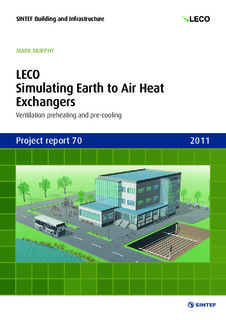| dc.contributor.author | Murphy, Mark Allen | |
| dc.date.accessioned | 2016-11-04T21:15:42Z | |
| dc.date.accessioned | 2016-11-09T06:54:07Z | |
| dc.date.available | 2016-11-04T21:15:42Z | |
| dc.date.available | 2016-11-09T06:54:07Z | |
| dc.date.issued | 2011 | |
| dc.identifier.isbn | 978-82-536-1193-8 | |
| dc.identifier.isbn | 978-82-536-1192-1 | |
| dc.identifier.issn | 1504-6958 | |
| dc.identifier.uri | http://hdl.handle.net/11250/2420221 | |
| dc.description.abstract | A primary objective with passive houses is to reduce the energy demand for heating and cooling. A well-insulated and airtight building envelope, highly efficient heat recovery within the ventilation system, low-energy windows and doors, and thermal bridge free constructions are common characteristics for passive houses. When all these characteristics are in place, what becomes the next step? What else should one improve in order to reduce the energy use of the building? One possible answer could be to improve the ventilation system by installing an earth-to-air heat exchanger (ETAHE). An ETAHE utilizes the thermal mass of the soil surrounding or beneath the building in order to preheat or pre-cool incoming ventilation air. With the ground’s large thermal capacity and relatively stable temperatures, outdoor temperature variations are dampened and ventilation h eating and cooling loads are reduced. Using the building energy simulation software TR NSYS, this report investigated the heating potential and cooling potential of an ETAHE in a mechanically ventilated passive house, ranging in size from a detached house to a small office. Simulations of the ventilation system within a small office indicate that a parallel piped ETAHE, connected to an efficient air handling unit, will provide energy savings ranging between 6 and 14.6 kWh/m 2 floor space during a normal year with base ventilation at nigh t and 4 air circulations per hour during day. | |
| dc.language.iso | eng | nb_NO |
| dc.publisher | SINTEF akademisk forlag | nb_NO |
| dc.relation.ispartofseries | Prosjektrapport (SINTEF Byggforsk);70 | |
| dc.subject | Simulation | nb_NO |
| dc.subject | Earth to Air Heat Exchangers | nb_NO |
| dc.subject | Ground Coupling | nb_NO |
| dc.subject | Energy savings | nb_NO |
| dc.subject | Office buildings | nb_NO |
| dc.subject | Energibruk | nb_NO |
| dc.subject | Kontorbygg | nb_NO |
| dc.title | Leco. Simulating Earth to Air Heat Exchangers. Ventilation preheating and pre-cooling | nb_NO |
| dc.title.alternative | Simulating Earth to Air Heat Exchangers. Ventilation preheating and pre-cooling | nb_NO |
| dc.type | Research report | nb_NO |
| dc.date.updated | 2016-11-04T21:15:42Z | |
| dc.description.version | publishedVersion | |
| dc.rights.holder | © 2011 SINTEF Building and Infrastructure | nb_NO |
| dc.subject.nsi | VDP::Teknologi: 500 | nb_NO |
| dc.subject.nsi | VDP::Technology: 500 | nb_NO |
| dc.identifier.cristin | 1268217 | |
| dc.description.localcode | 3B015100 | |
